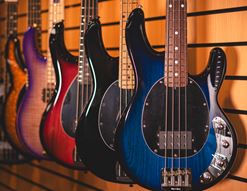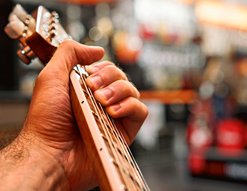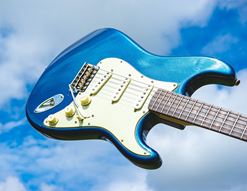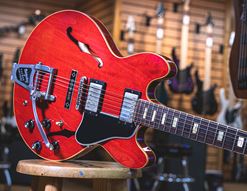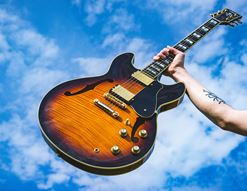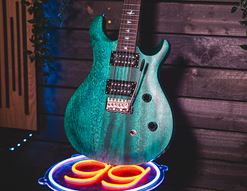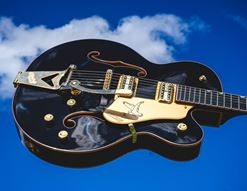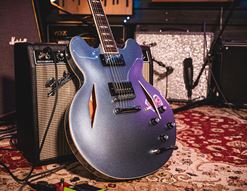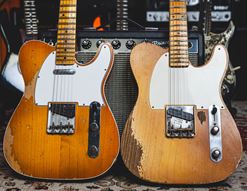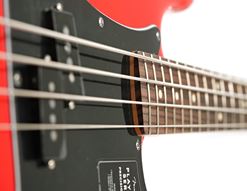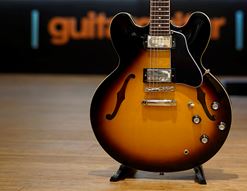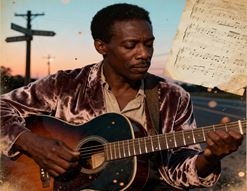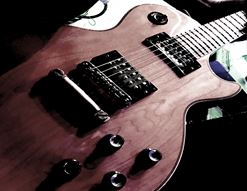Are you playing a steady stream of paid gigs? Good one! Well done to you: you’re out there doing it and that is excellent. That’s what it’s all about: performing, connecting with people, spreading your message and having fun. What else is there, really?
So, what are you bringing to your gigs? You can play any music on any guitar, let’s get that out of the way. But if you are a busy, gigging player, then you’ll know that some guitars get the job done better than others.
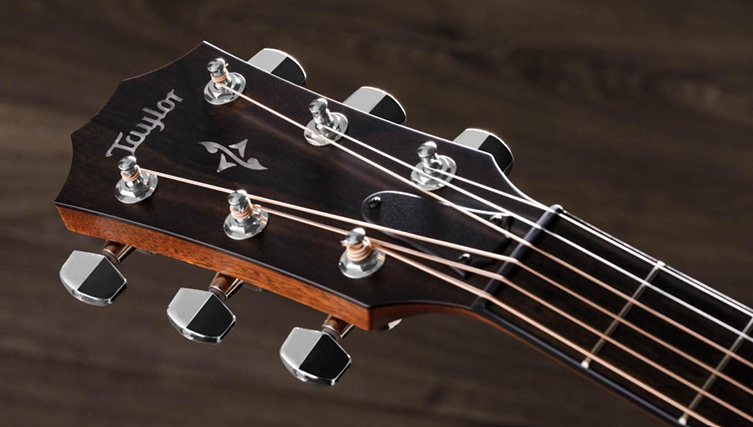
Gigging guitars sit in cold cars for hours, get rattled around on the tube and train, and then are brought into warm venues for a few hours before going through all of that again, week after week. They need stability.
Gigging guitars need to sound great when they are plugged into a preamp or mixing desk. This is actually more important than how it sounds naturally, in this case. The audience hears the result of the guitar’s sound through a pickup, a mixing desk and then some PA speakers, so that end result is the important tone, not the one you hear when strumming at home in front of the telly.
But if the initial sound from the guitar isn’t already good to begin with, no amount of EQ’ing or effects wizardry from a live sound engineer is going to be able to polish it much. You need a great sounding guitar and a great sounding pickup system, basically.
For this reason, I believe Taylor are a great choice. They offer a very large selection of instruments, and, impressively, many models share the same great technology and building know-how of the more upmarket models, so you can enjoy a pro-spec guitar without necessarily breaking the bank. Taylor obviously do offer proper museum-pieces, too (check out my Top End Taylors blog), but these aren’t the focus for today.
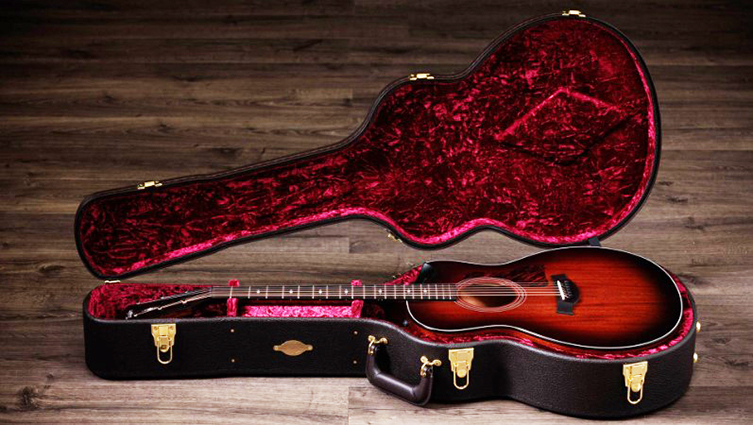
Today I’m looking at the guitars you’d take to the gig. The workhorses that deliver, night after night, in boozy rooms and rowdy halls, when you need a reliable and hardy instrument to power yourself through another spirited gig. What many pro players don’t need is a top, top, top end guitar, as nice as they are: they need something from the middle ranges that offers an excellent sound and playing experience.
I’ve got just the thing. Three, in fact!
The Taylor Range
Taylor guitars are available in a wide variety of subranges and editions. If you’re not too acquainted with them, please have a look at my other blog - Taylor Series Explained - and you’ll find the info you need.
For the purposes of today’s blog, I’ll point out that the standard offerings range from a 100 series to a 900 series, with each range more or less increasing in spec, decoration, features and of course price. I’ve endeavoured today to sculpt out a specific gang of guitars from the 200, 300 & 400 series: the middle ranges, as I see them, when you consider GS Minis etc. These ranges are where you get maximum performance and quality, but they don’t add in too many cost-increasing decorative details. Rare timbers too, are something we can live without for now, when performance and sound are the main factors.
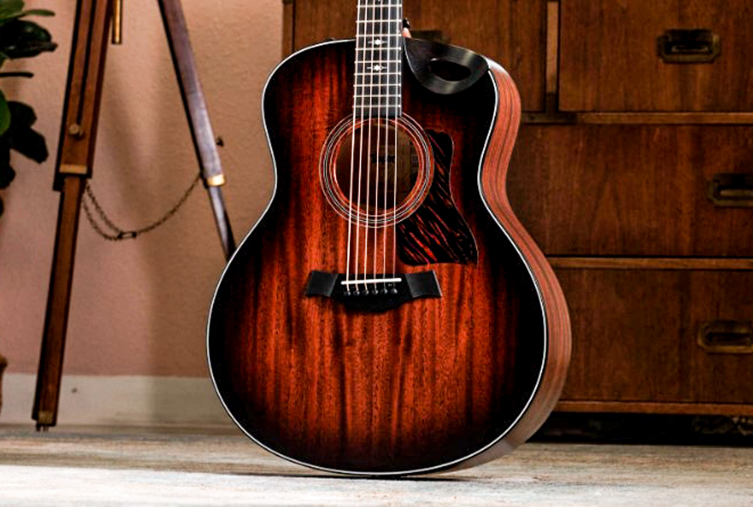
Taylor Expression System
Because the plugged-in factor is so significant, I’ll say a quick note on Taylor’s own pickup system, the Expression System 2. Also known as the ES2, this is actually one of the best acoustic guitar pickups on the market, and a big reason why I believe Taylor acoustics to be such a good idea for gigging players.
In simple terms, the ES2 sits underneath and behind the guitar’s bridge saddles and has three specially placed sensors for picking up sound. These sensors are placed in order to pick up a greater range of dynamics than previous technologies. The pressure of each sensor is set at the factory (no adjustments required by you, phew!) and this all connects to a specially-developed preamp unit.
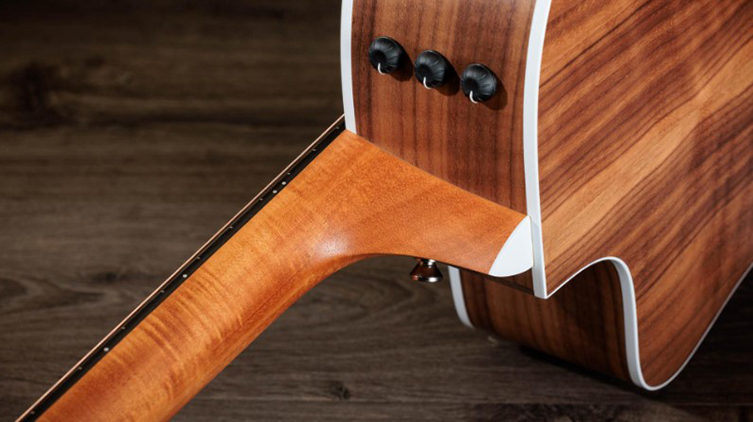
With this setup, you can pretty much go directly into a mixing desk and expect to sound good. That is not something I could say for a good deal of built-in pickups, so it’s worth highlighting! There are many ways of working a pickup into an acoustic guitar, but this one is definitely one of the better ones.
Taylor Naming Codes
When diving into the Taylor catalogue, it does pay to understand their numeric naming conventions. It’s not exactly Da Vinci Code stuff, but there is a key to it, so whilst I’d refer you back to that Taylor Series Explained blog for the full rundown, here’s a brief recap:
- 1st number: the series (100 series, 300 series etc)
- 2nd number: ‘hard’ or ‘soft’ timber (don’t worry too much about this) & whether or not it’s a 12-string model
- 3rd number: the body shape. For example, 0 is a dreadnought shape, and 4 is Taylor’s signature Grand Auditorium.
To put this into context, a Taylor 314ce is a 300 series (the 3) spruce-topped (the 1) Grand Auditorium (the 4) guitar, and the ‘ce’ denotes cutaway electric, meaning the guitar has a cutaway in the corner of the body for easier fret access, and there’s a pickup system fitted.
Simple!
So, let’s now check out a few Taylor models, selected by myself, that are sure to meet your live-performance requirements! I’ve picked one model each from the 200, 300 and 400 series, as a way to illustrate and cross-reference what’s out there for you. Take these as personal recommendations, but also as jumping-off points for your own investigations: much of the info that follows can be applied elsewhere in the world of Taylor guitars, so have a read and check out what’s available!
The Affordable Workhorse - Taylor 214ce
First off, I’d like to highlight the Taylor 214ce, because I believe it is very difficult to beat this guitar at this particular price point. As I write this article (September 2024), the 214ce sells for £999, and I think that’s a more than fair price for what you get!
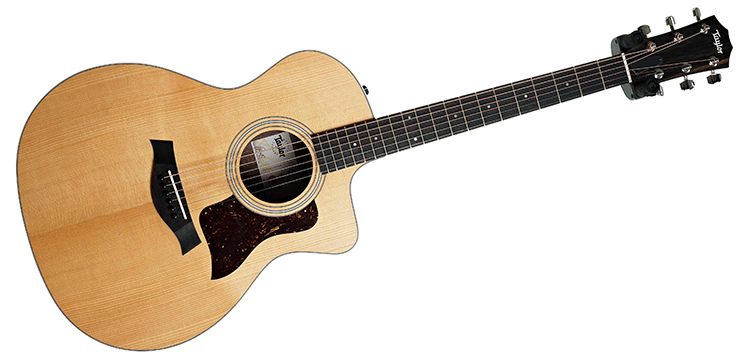
But what do you get? Let me break it down into fun bullet points:
- Grand Auditorium body shape: this is Taylor's most popular shape, and that comes as no surprise: it’s comfortable for all and projects particularly well despite its slightly smaller size. It is also an attractive shape, and that sort of thing matters when you’re onstage!
- Timbers: this model isn’t fully solid (the back & sides are layered rosewood), but the top is solid spruce and you also get an ebony fingerboard, which isn’t something you see loads of at this price! (Note: ‘Crelicam’ Ebony is simply ebony from Taylor’s own socially & environmentally responsible premises in Crelicam, Cameroon, which is in central Africa).
- ES2: the excellent Expression System 2 is on this guitar, meaning it will sound very good when plugged in.
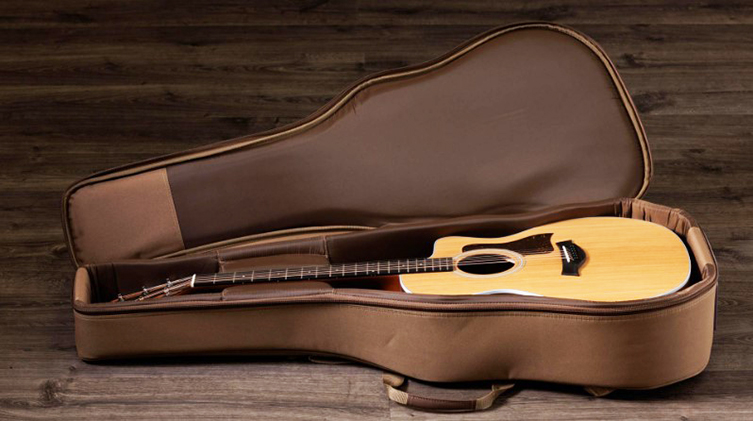
The Taylor 214ce is light on the decoration, but I’d say that’s actually a good sign: it means that you’ll be spending your money on the build and the sound, rather than on aesthetic elements that don’t add much to either tone or feel. I think decoration and ‘vibe’ are important, actually, but I also think that you do pay for them, so Taylor are wise to focus on the performance here, saving the fancy appointments for higher-priced guitars.
This instrument is an excellent workhorse that outperforms the competition. It’s stripped back and ready for action!
The Jumbo Alternative: Taylor 326ce
For performers who are mostly singing and strumming, this guitar is a fantastic choice. With acoustic guitars, as I’m sure you already know, physical size generally equates to sonic size: the bigger the body, and bigger the sound.
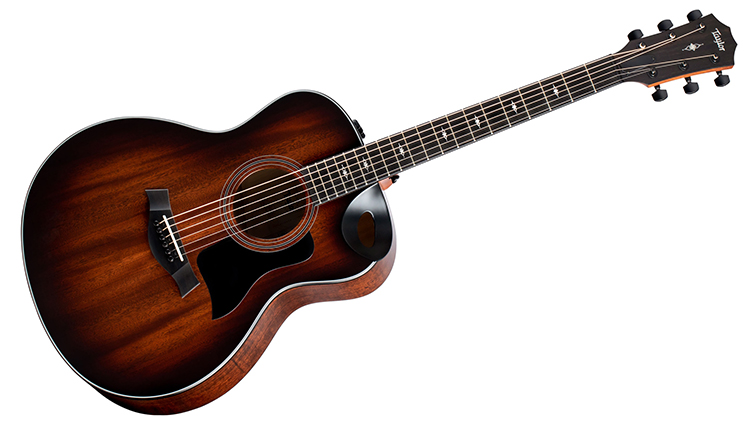
So it is with the Taylor 326ce. The 300 Series is the first to have all-solid timber construction, and whilst I do think that you can still achieve great results with solid top-only guitars, fully solid guitars just resonate better. This allows for richer fundamentals and overtones in your tone, all of which is shaped by timber choice and body shape.
This gorgeous guitar is a Grand Symphony shape, and whilst Taylor do offer the larger Grand Orchestra body, I’d still equate this one with the sound of a jumbo. This means a large, room-filling sound that’s heavy on percussiveness, which is just the ticket for singers who want to accompany themselves. Check out some of the interesting things you’ll find on this guitar…
- All mahogany construction: mahogany sounds strong and warm, so when it’s used on a bigger body like this, you get a very full, authoritative tone emerging.
- V-Class Bracing: Taylor’s patented inner bracing gets even more volume and sustain out of this design, helping your notes to both soar and gel together very pleasingly.
- Soundport cutaway: soundports are small soundholes, basically, and this one - built into a sort of cutaway in the lower bout - helps distribute the sound in a more three-dimensional way. Surround yourself and your audience with sound!

This 326ce is a good looker with its sunburst finish, white body binding, ebony fingerboard and intricate inlays. The soundport cutaway is a real talking point too, and gives this guitar a unique look. For a top quality songwriting machine, look this way!
The Dreadnought Redefined: Taylor 417ce Grand Pacific
Since this is a blog on relatively affordable Taylor guitars, I realise I’m pushing it a bit by sticking in something that costs two and a half grand, but then, if you are playing a lot of gigs, this is entirely within reach and appropriate to your level as a musician.
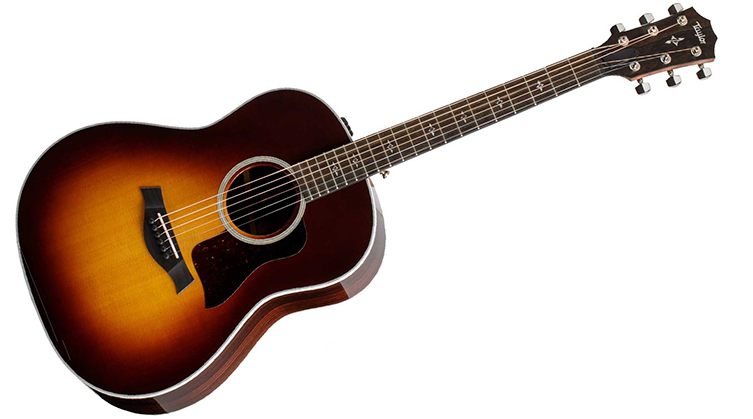
The Taylor 417e-R is from their 400 series, and this means a Sunburst finish, a Spruce top and a rosewood for the back and sides. Let’s break this down into bite-sized factoids:
- Sitka spruce and Indian rosewood: Now this is just a classic combination of tonewoods, used for many decades due to how complementary they are to each other. Spruce is bright and clear, whereas rosewood is strong and rich. Together, they bring a wonderful sound that is, for many, the epitome of great acoustic guitar tone.
- Grand Pacific shape: this is relatively new for Taylor, and it’s like a contemporary redrawing of the dreadnought style. Large sounding and round, this warms up the timber combos and smooths some of that top end to make a powerful, very balanced sound.
- V-Class Bracing: as we’ve covered, Taylor’s V-Class bracing adds power and volume, along with some beautiful sustain. This thing rings like a bell.
- Huge versatility: given the shape and the timbers used here, there is pretty much nothing that this guitar cannot do, genre and style-wise.
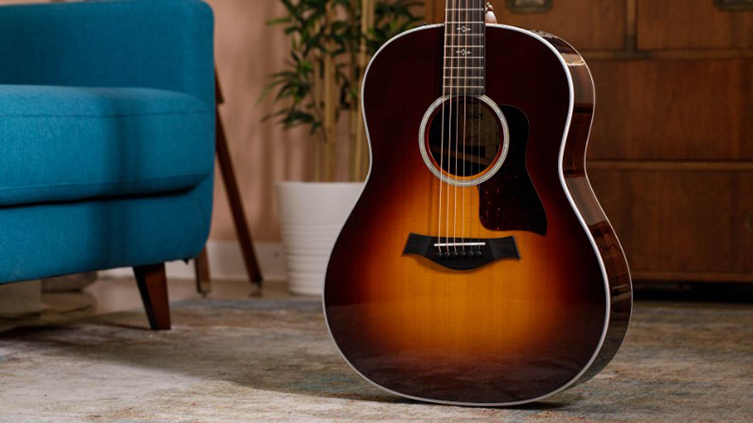
This handsome guitar can fit itself into any musical situation and do well. The design is well considered, as are the chosen timbers, and the whole package just resonates with quality. The ES2 pickup is of course fitted too, so plugged-in situations will be very rewarding indeed.
Taylor: Quality at Every Point
No matter which series you buy from, Taylor pack in a lot of value. Today, we’ve looked at a tiny little grouping of guitars, and all of them offer something to the busy gigging player. Which one resonated with you? Remember, there are lots of variations of offer, so you can look ‘sideways’ from my recommendations, if you get me, and choose, say, a 210ce (dreadnought shape) instead of the 214ce. The shape changes, but the rest of the spec remains.
The question of what guitar is right for you is ultimately something that only you can answer. Looking at this guide today has hopefully put some of Taylor’s output into a particular context, and one that you can then spring from and conduct further research.
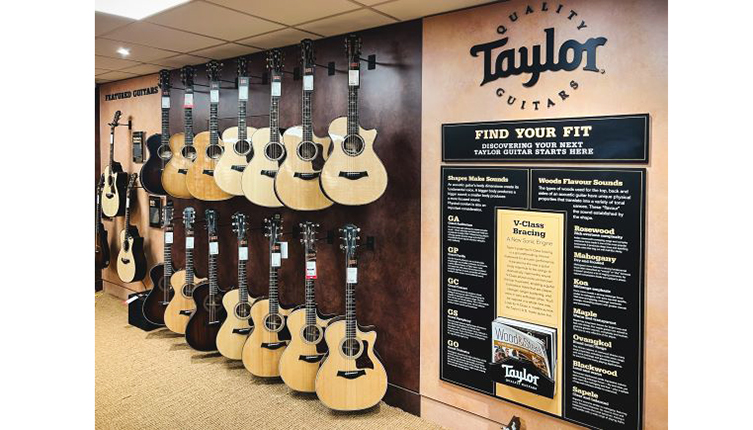
Speaking to that, there is no better research than just getting in a room with a few of these and exploring them together. You’ll find what you like, what you don’t, and start narrowing down that wide playing field until you land on your personal best guitar. It’s a great thing to do, so why not start today?
Click to View our Taylor Acoustic Guitars

